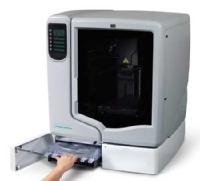Additive Laser Manufacturing (ALM 3D Printing)
Additive Laser Manufacturing, or 3D Printing, is a rapid prototyping-manufacturing method used to reduce process time, product weight and use of raw materials. Typically, products can be generated through 3D printing can be made with lower CO2 emissions, lower water requirements, less virgin material (material extracted from natural resources), less potentially hazardous materials, less energy and finally less landfill waste.
Now, 3D printing offers a faster, low-cost alternative to traditional rapid prototyping for building concept and working models. A part built using 3D printing technology can cost nearly half that of one built using traditional rapid prototyping methods. Costs are reduced in areas such as materials, machine depreciation, system maintenance and labour.
 How does it work?
How does it work?
3D printing is an additive technology and work by converting a 3D digital design into thin printable cross sections. This information is then sent to the machine where it starts to deposit material layer by layer, thus creating a 3-Dimensional object.
Applications:
Most current 3D printers are not used to create final consumer products. Rather, they are generally employed for rapid product prototyping, or to produce moulds or mould masters that will in turn allow the production of final items – in particular, jewellery, packaging, containers, dental appliances, clothing, model vehicles for wind-tunnel measurement.
Sample handling requirements:
Digital File of 3D model (a number of file formats are compatible, for example *.DAE, *.3DS, *.OBJ, *.PLY, *.V3D, *.OFF, *.PTX, *.ALN)
Complementary techniques:
Multijet Modelling, Laser Sintering, Stereo Photolithography.
Warwick capability:
ALM 3D Printer
Contact:
Claire Gerard: c dot gerard at warwick dot ac dot uk / 07385 145064
Typical results format, and sample:
Status |
Availability |
|
|
Warwick collect/analyse data |
| Warwick collect data | |
 |
Available to user with expertise/ contribution |
 |
Spare capacity for collaborative research |
BOOK NOW |


